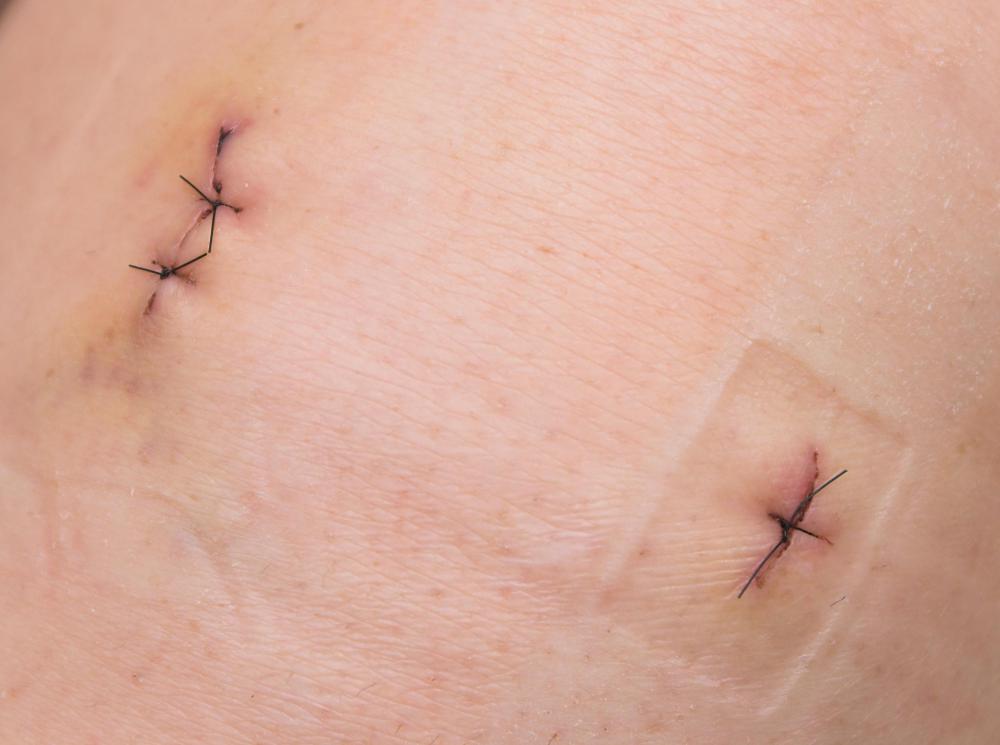At WiseGEEK, we're committed to delivering accurate, trustworthy information. Our expert-authored content is rigorously fact-checked and sourced from credible authorities. Discover how we uphold the highest standards in providing you with reliable knowledge.
What is a Melanoma Biopsy?
A melanoma biopsy is a medical procedure that diagnoses melanoma, a dangerous form of skin cancer. There are three types of melanoma biopsies: excisional, incisional and punch. Each biopsy involves taking a sample of the suspicious area, such as a mole or growth, for analysis. Though a doctor might be able to detect skin cancer by sight, a biopsy will confirm what a visual diagnosis of the condition suggests. If a biopsy reveals a malignant presence of melanoma, the next step might be another procedure called a sentinel node biopsy.
An excisional biopsy is a type of melanoma biopsy in which the doctor removes the entire suspicious area for analysis. In addition, he might also remove the normal-looking skin that borders the suspicious area. An incisional biopsy is second type of melanoma biopsy where the doctor only removes part of the suspicious area, usually the most irregular part, for analysis. A third type of melanoma biopsy is a punch biopsy, which is a procedure mostly for the purpose of removing samples that might be deeper in the skin. For a punch biopsy, the doctor presses a tool that has a circular blade around the suspicious area and removes a round piece of skin.

The depth and size of a suspicious area, as well as the depth and size of the sample taken for a biopsy, vary with each individual case. In an excisional biopsy, if the suspicious area is large, the patient might also have to undergo a skin graft. Before a melanoma biopsy, the patient will receive a numbing medicine. Afterward, the doctor will close the area up with stitches if necessary.

A melanoma biopsy not only confirms the skin cancer, it also determines the stage, or severity, of a particular person’s condition. The find might be benign or malignant. If malignant, the doctor will need to know if the cancer has spread to any lymph nodes nearby. To ascertain this, the doctor might perform a different type of biopsy called a sentinel node biopsy.

In a sentinel node biopsy, the doctor injects a dye at the site of the biopsy sample. This dye travels to, and dyes, nearby lymph nodes. The doctor then removes the lymph nodes that take up the dye and tests them for cancer cells. Cancer-free cells are a good indicator, though not a guarantee, that there has been no spread of the melanoma. If the melanoma has spread, other tests will determine to what extent, and the doctor will recommend a treatment plan accordingly.
AS FEATURED ON:
AS FEATURED ON:














Discussion Comments
I had a punch biopsy for a place on my neck. It was benign, but that punch business *hurts*! It was number, but when the numbing wore off, I was in some pain. I had to be careful about what I wore for a week, mostly because anything that rubbed against the place hurt.
My doctor recommended I just cover up that place if I'm out in the sun, and I find a band-aid does as well as anything else. He just said that that was the smart thing to do and I agree with him. I don't want to run the risk of getting a skin cancer at that site, so a band-aid is an easy fix.
My mom had an excisional biopsy for a place on her arm. Thank the Lord it wasn't skin cancer, but her dermatologist said it was one of those places that could have sprouted a cancer at any time, so it was better, in his opinion, to get it off.
She didn't mind, and said it didn't hurt or anything. They numbed her arm and just basically scraped the place off the skin. She had a dressing on it for about a week, and the doctor saw it a week later and said it had healed well. He said the surrounding skin looked good, and she hasn't had any concerns since.
Post your comments